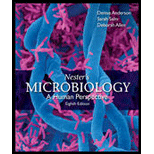
Concept explainers
Describe a detrimental and a beneficial effect of biofilms.
To review:
Description of a detrimental and a beneficial effect of biofilms
Introduction:
The microorganisms in nature can live permanently or temporarily in a hydrousenvironment but most attach themselves to surfaces and live in polymer encased communities called as biofilms. Biofilms causethe sticky substance that coats the drains of the kitchen, the sticky colorless deposit, which grows on surfaces within the mouth.
Explanation of Solution
The formation of biofilms begins when free-floating cellsmove to a surface and attach. Multiplication will then take place and will release hydrophilic polymers, DNA, and polysaccharides. The unrelated cells may attach and grow. The assembly of these polymersisreferred to as extracellular polymeric substances (EPS). EPS gives a biofilm its slimy appearance.
Biofilms have harmful effects. Biofilms can be formed anywhere especially on moist surfaces because it provides the good ground for the bacteria to grow. They tend to be resistant to antibiotics. Biofilms are seen growing around the surfaces of toilets, sinks, in hospitals, wound dressing. Complication of cystic fibrosis, in which the lungs and digestive systems get clogged with mucus, ear infection, heart diseases, and respiratory problems, isthe harmful effectof biofilms. These infections often require a high dose of antibiotics to get rid of the body and it requires a long time.
Biofilms have beneficial effects. They are important for wastewater treatment facilities. The various microbial activity in the water is controlled in the biological treatment of wastewater. This is the filtration process where the wastewater is treated. The conversion of organic carbon in the water into bacterial biomass is the biological filtration. This process makes the treated water more biologically stable and free of all disinfectant. Biofilms are used in the process of bioremediation of contaminated soil. Bioremediation is the process where the toxic organic material is converted into a harmless product. Various toxic contaminants(gasoline, fuel oil) are released accidentally underground in the soil. The bacterial population present in the native soil will use the organic contaminants as a food source. Thus they will make the soil free from all the toxic organic contaminants and will convert them into harmless by-products.
Thus, the harmful effect of biofilm is seen in various health-related problems, such as respiratory disease, ear infection, and a complication of cystic fibrosis. The beneficial effect is seen in the treatment of urban wastewater, bioremediation of contaminated soil.
Want to see more full solutions like this?
Chapter 4 Solutions
Nester's Microbiology: A Human Perspective
- Explain the purpose and phase where cells lose flagella and motility in biofilm formation, and why the amount of cell density is an important factor in type of bacteria where biofilm formation is triggered.arrow_forwardDescribe why bacterial biofilms can be a threat to human health.arrow_forwardDescribe a microbial biofilm. Discuss why it is likely that a biofilm contains bacteria with different energy metabolisms?arrow_forward
- Describe the steps in biofilm formation using the words planktonic organisms, quorum, quorum sensing, extracellular polymeric substances, and inducer molecule.arrow_forwardRelate several advantages to communication within a biofilm.arrow_forwardDescribe how each of the following physical factors affect microbial growth and aid in classification: a. temperature b. pH c. molecular oxygen d. osmotic pressure.arrow_forward
- Describe a biofilm and explain how it benefits its inhabitantsarrow_forwardList and describe the steps of biofilm formation. Explain how and where (specific places and equipment) biofilms can be harmful in a health care setting. Include an example of a microbe commonly known to form biofilms in the health care setting. Along with that example, explain what preventative measures can be taken to prevent a biofilm of that microbe from forming.arrow_forwardBiofilms often consist of multiple species of bacteria.True or false?arrow_forward
- Essentials Health Info Management Principles/Prac...Health & NutritionISBN:9780357191651Author:BowiePublisher:Cengage
